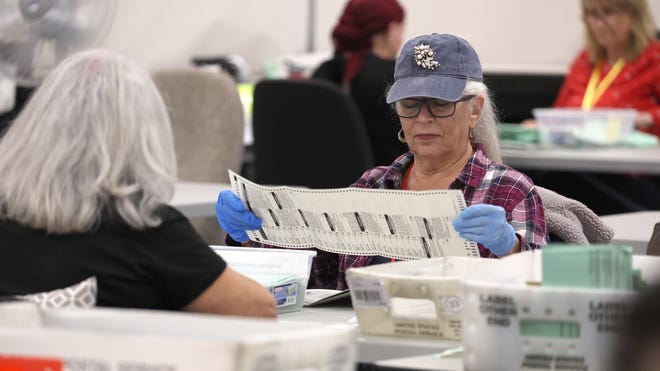Despite Donald Trump officially securing a second term as president, Arizona remains in the spotlight as election officials continue to tally ballots days after the November 5 contest.
As of Friday morning, the Arizona Secretary of State’s office reports that over 780,000 votes are still uncounted. Preliminary results indicate Trump leads Kamala Harris by 5.9 points, while Democratic Senate candidate Ruben Gallego holds a 1.7-point advantage over Republican Kari Lake.
The state legislature’s control, along with several local races, also remains undecided as of Friday morning, according to The New York Times.
Although Arizona is no longer critical for Republicans to win the White House and Senate this year, the state’s reputation for extended vote counting should not be overlooked.
“The longer you drag it out, the more it raises suspicions that shenanigans are occurring, that fraudulent activity is occurring,” Arizona Free Enterprise Club President Scot Mussi told The Federalist. “The only way to eliminate that is to ensure that we have election results on election night.”
Failing to deliver clear election results on the day of the vote undermines public trust in the electoral process. Imagine if the outcome of the 2024 presidential race hinged on Arizona’s results. The inability of officials in Maricopa County—Arizona’s largest county—and other areas to implement timely procedures would likely lead to a major crisis of confidence among Americans.
“This has to stop; the drawn-out process is eroding trust in the system,” Arizona GOP Chair Gina Swoboda told The Federalist.
While Arizona, especially Maricopa County, has faced multiple election management issues, the main obstacle to timely results stems from state law, according to Mussi and Swoboda.
In Arizona, voters can return their early mail ballots by mail or in person at any vote center within their county until 7 p.m. on Election Day. Absentee voters must sign the ballot envelope affidavit, which is then matched to the signature on their registration. Once confirmed, the ballot is processed and counted.
The Arizona Secretary of State’s office indicates that “most” early mail ballots returned before Election Day are “tabulated in the weeks leading up to the election.” However, the issue lies with how counties handle early ballots returned on Election Day, which delays timely election results.
According to Swoboda, the primary reason Arizona struggles to produce prompt election results is that state law allows voters to submit early ballots on Election Day.
In Maricopa County alone, officials reported that over 212,000 early ballots were dropped off at voting sites on Election Day. When factoring in early ballots received from drop boxes and the Post Office, that number rises to over 225,000.
These Election Day mail ballots, along with those in other counties, must go through the signature verification process before they can be counted—a process the Secretary of State’s office notes “takes time.”
“This delay we’re going to have from today to Saturday is 100 percent caused by voters being allowed to drop off [hundreds of thousands of] ballots in envelopes on Election Day,” she said.
Constantin Querard, president and founder of Arizona-based Grassroots Partners, suggested that the two-page, double-sided ballot used in Maricopa County and other areas may be contributing to delays in releasing election results. Speaking with The Federalist, he noted that while everything “seemed fine” early on election night, it quickly became clear that Maricopa officials were unprepared for the operational challenges posed by the unusually lengthy ballot as the evening wore on.
“They clearly got something wrong leading up to [election night] because they were way behind and that first ballot drop was light,” Querard said. I find it “hard to believe they were surprised by the scale of the operation, but it seems the two-sheet ballot really messed with their estimates.”
Mussi told The Federalist that while he doesn’t think officials like Maricopa County Recorder Stephen Richer are deliberately prolonging the “broken” system, Richer and others “actively defend it and believe that it is working.”
Despite Arizona’s ongoing challenges in providing timely election results, legislative efforts to improve the efficiency of the state’s tabulation process have faced obstacles.
In 2022, the Arizona Legislature amended state law to permit counties to perform “on-site tabulation of early ballots.” However, according to Mussi, none of Arizona’s 15 counties have adopted this practice.
“That law has been in place since 2022. They could [have done] it for this election,” Mussi said. “We’re going to urge counties after this election to implement that, to provide that option [where] if [a voter has] an early ballot, they could go to a location, show ID, [and] tabulate their ballot on site. That will address the vast majority of the issues we’re having now with [not] getting election results on election night.”
Swoboda told The Federalist that state Democrats and the counties’ lobbying organization have opposed “every bill” proposed by Arizona Republicans that would require localities to implement on-site tabulation for early ballots dropped off at polling sites on Election Day. She suggested that this opposition — which she believes undermines confidence in Arizona’s elections — may be driven by their interest in moving the state toward an all-mail voting system.
“They don’t want to do anything to make the in-person voting experience better because they believe that they can get us to go to all-mail,” Swoboda said. “I understand why they want it, but they’re not going to get it … because we have a right to vote in person.”
While mandated on-site tabulation remains a significant obstacle, new legislation passed earlier this year could help reduce some existing backlogs.
Starting in 2026, the bill allows voters to “provide identification” that meets current statutory standards when submitting their mailed early ballot at a polling site on Election Day. Once election officials “verify that the name and address on the ID reasonably match the voter’s registration record” and mark the signed affidavit with an “ID verified” stamp, the ballot is placed in a designated ballot box and considered “ready” for tabulation, as the voter’s identification has already been confirmed.











